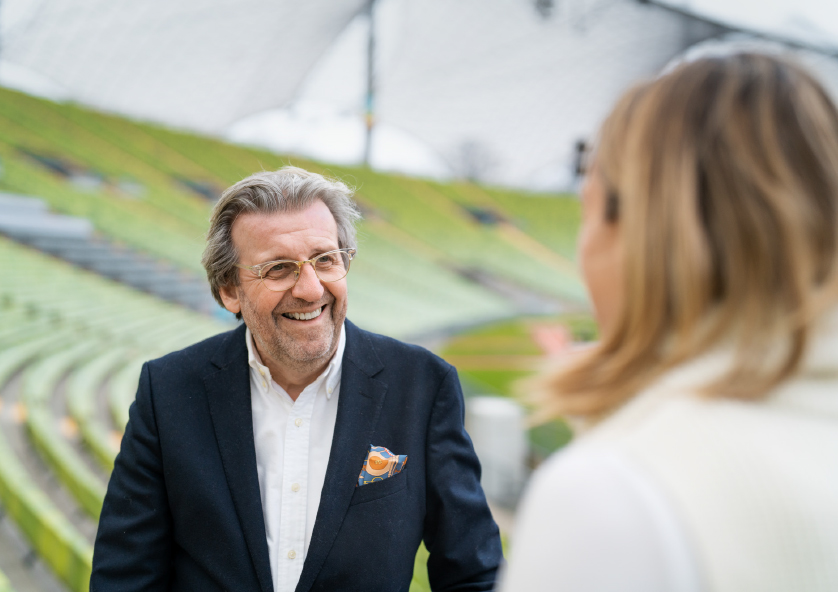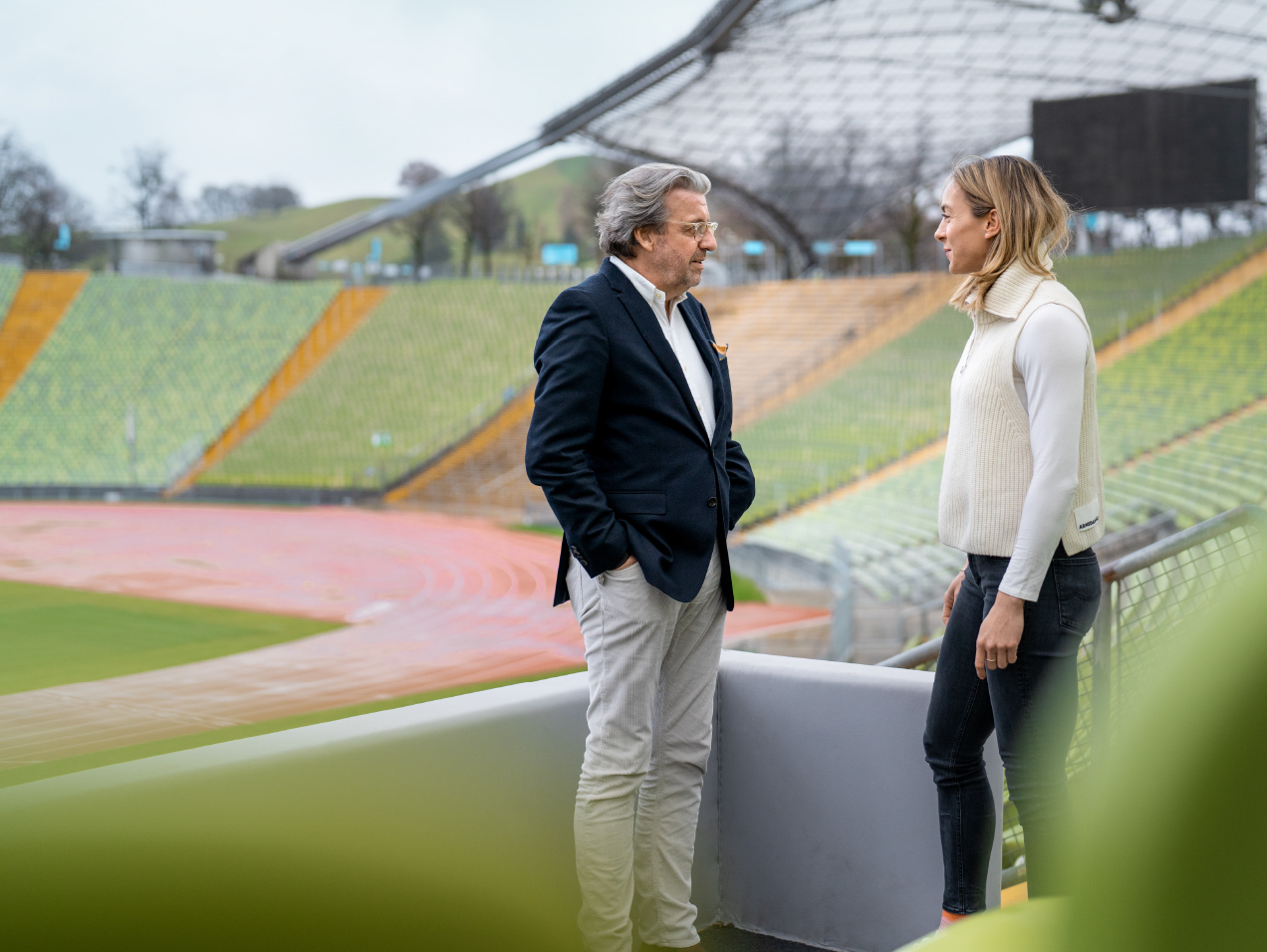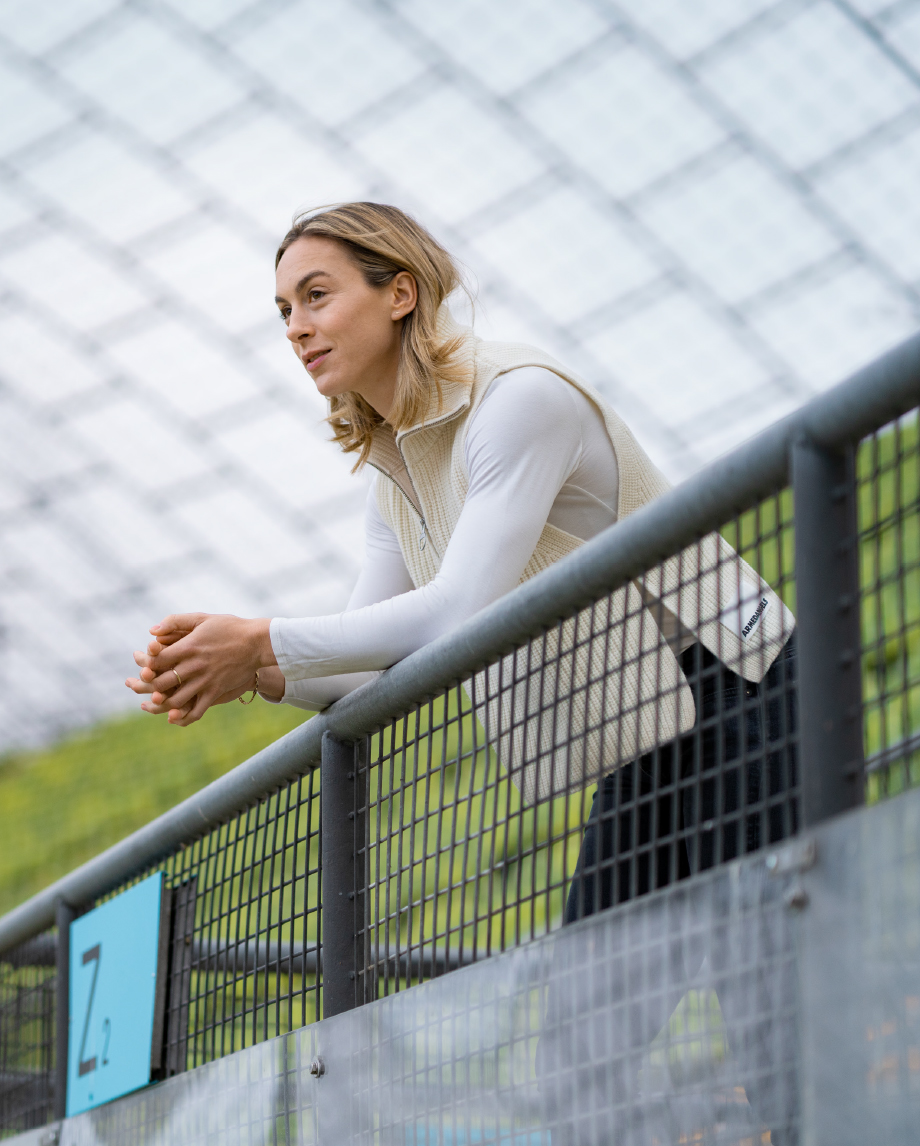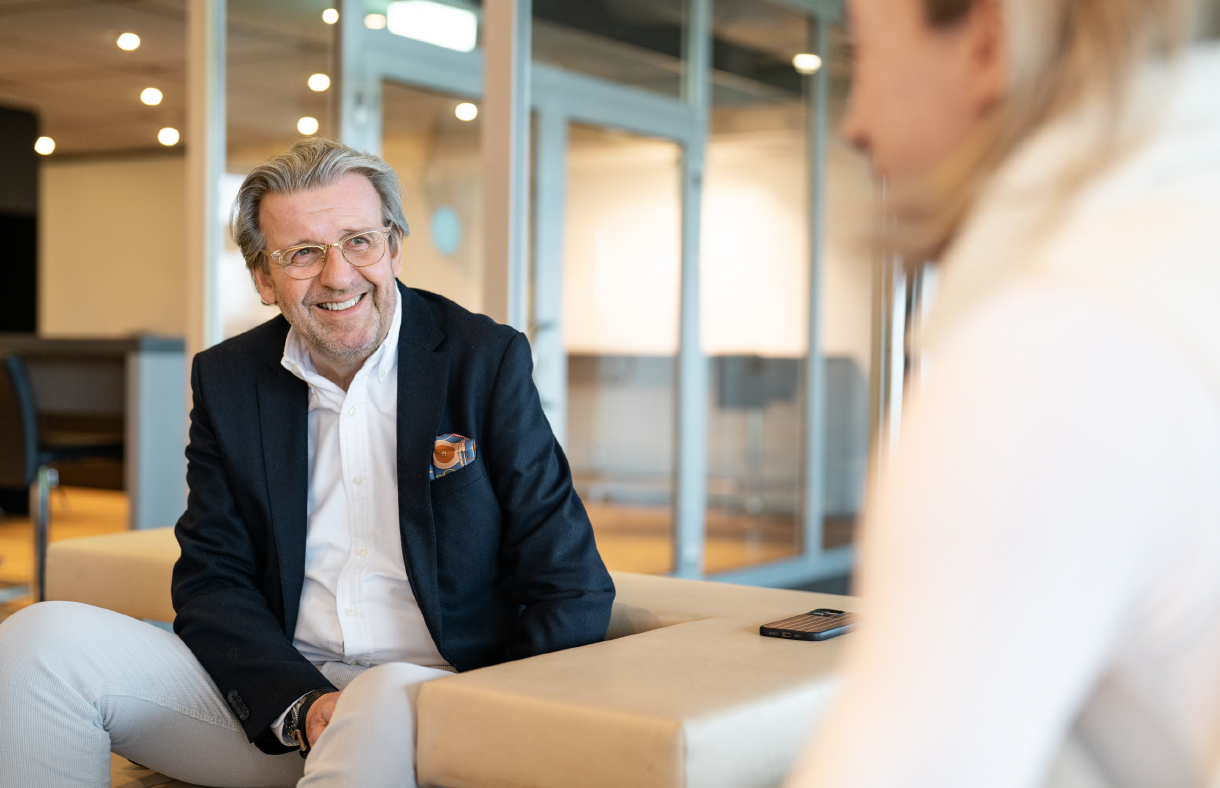
GO
Whether your chosen arena is top-level sport or business, it all comes down to speed. While runners aim to leave their competitors trailing in their wake, ElringKlinger has picked up the rapid pace of the automotive industry as it undergoes major change. This interview brings together Alexandra Burghardt, sprinter and pusher in the two-woman bobsleigh, and Dr. Stefan Wolf, CEO of ElringKlinger.
No sooner had Alexandra Burghardt finished training at the German national athletics training center in Munich’s Olympiapark than the elite sportswoman was meeting ElringKlinger CEO Dr. Stefan Wolf for a conversation at the Olympiastadion right next door. It was here that the sprinter won relay gold at the 2022 European Championships, having already been on the podium half a year earlier as a silver medalist in the two-woman bobsleigh at the Beijing Winter Olympics. Whether she’s on the running or the bobsleigh track, Alexandra Burghardt is the woman to beat when it comes to speed. She talks to Dr. Stefan Wolf about why staying still isn’t an option and how someone can put their strengths to the best possible use.
Ms. Burghardt, when does speed thrill you the most?
Alexandra Burghardt: When I’m sprinting, at that moment when I’m accelerating out of the starting blocks and I hit my top speed. In those few seconds, I feel the power increasing with every step. It feels fantastic when this power doesn’t fizzle out, isn’t slowed down by anything.
You’re considered to be a brilliant starter.
Alexandra Burghardt: Yes, that’s why I enjoy it so much [laughs]. But bobsledding has taught me another side to speed. When I’m running the 100 meters, my average speed is somewhere around 33.5 kilometers an hour. In the bobsleigh, we can get up to 130 km/h, although as a pusher I’m at the mercy of whatever speed our sled is going at, combined with 100% trust in my pilot. The forces I’m exposed to in the bobsleigh are unique. They go up to six or seven g…

"That the change is moving ever faster is undoubtedly a good thing in our view. We can keep up with this pace."
Dr. Stefan Wolf, CEO of ElringKlinger AG
… by way of comparison, the fastest rollercoaster in Germany has a maximum force of four g.
Alexandra Burghardt: When you’re in the bobsleigh, it pushes your head down. You feel the force of your speed so much that you’re no longer in control of what you’re doing.
Dr. Wolf, when do you feel speed and dynamism in your company?
Dr. Stefan Wolf: Definitely with the speed at which electromobility is making progress at the moment. We spent a long time as a supplier of components for combustion engines – the traditional business in the automotive industry. As early on as 20 years ago, I realized that there’d come a change: moving away from the combustion engine and toward new, climate-friendly drive technologies. Even back then, therefore, we began to come up with innovations for the fuel cell. Battery technology was then added 15 years ago. So we were on it very quickly – and yet I’m still surprised by the speed of this change that we’re now seeing in Europe in particular. And this pace will definitely keep on picking up. Because of the various sets of regulations, but also because people are demanding this much speed, especially the younger generation.
Dr. Stefan Wolf and Alexandra Burghardt are meeting for a conversation in Munich’s Olympiastadion. It was here that the sprinter won relay gold at the 2022 European Championships.

Ms. Burghardt, you came here in an electric car.
Alexandra Burghardt: Absolutely. I generally really like driving and am happy to say that electromobility has become a lot more convenient over the past few years, both in terms of the actual driving and the quality of the charging infrastructure.
Dr. Stefan Wolf: The convenience has to be there, that’s essential. Plus there’s also the fact that climate action and sustainability are continuing to grow in importance. The technologies of electromobility are without doubt the areas we should be focusing on in the future. That developments are moving ever faster is undoubtedly a good thing in our view. We can keep up with this pace.
Ms. Burghardt, if someone watches you before a race, they’ll see that you become really calm and concentrated. What are you thinking about in that moment?
Alexandra Burghardt: I’m attempting to visualize the race one last time and play it through in my mind. It’s a method I learned while working with my mental coach. I think about the best possible way the race could go, where I put all my training into practice.
Do you always run a new personal best in your mind’s eye? 100 meters in less than 11.01 seconds, in other words?
Alexandra Burghardt: Definitely. When I’m going through the race in my head, I pull away from the other athletes and cross the line in under 11 seconds. It’s not wishful thinking, though – it’s part of my mental training. If I want to pull out my best performance, I first have to leave myself in no doubt that I’ve got it in me to do it. Feelings of self-doubt before the race won’t do you much good. So I’m visualizing a perfect race in my mind.

"Having a plan – and then seeing it through: that’s the secret to success."
Alexandra Burghardt, sprinter and pusher in the two-woman bobsleigh
Dr. Stefan Wolf: Getting and staying ahead of the pack is what drives us too, of course, particularly in terms of technology. Here’s an example: when it comes to performance density, which is a key criterion in drive technology, we’re the global leader with our fuel cell stacks. Anyone generating 200 kW with our stacks would need 1.5 times as much volume if they were using a competitor’s version. But we can’t afford to be satisfied with this position of superiority. We’ll have to work hard to increase our lead further with the next generation of stacks. And we also need to push the 10,000 people who work for us across the Group, but do so in a positive way: if we exert ourselves, we’ll manage it! Because, although we’re good, our ambition is to get even better.
Ms. Burghardt, why is it important for you to have ambitious goals?
Alexandra Burghardt: Dreaming of ambitious goals is the first step toward actually achieving them. Ahead of major competitions such as the World or European Championships, people often ask me what my goals are. I don’t hold back, and deliberately so. Which sometimes leads to me just failing to reach one of these goals. Then it’s not long before people say, “Big setback, that!” But I don’t see it that way. If you want to achieve your goals, you shouldn’t be afraid to tell everyone what they are. And if it just fails to come off once in a while…
Dr. Stefan Wolf: …then you learn from it in order to be better next time. Absolutely right. Unfortunately, however, we in Germany don’t have the same healthy culture of failure that exists in the US. If a fledgling start-up over there fails to make it, the founders tell themselves, “We’ll learn from that – and do better on our next attempt.” This kind of culture produces a constant stream of ideas and innovations. In Germany, by contrast, any kind of setback leaves you permanently branded a failure. I think that’s completely the wrong attitude, because good developments are born out of a willingness to try things out, learn from your mistakes, and thus get better.
Ms. Burghardt, you switched sprinting coaches in 2019. Your new coach said he thought that your running technique was wrong because you were slowing yourself down with each step. How did it feel to have somebody new come up to you and say, “You’re running in the wrong way?”
Alexandra Burghardt: I was extremely glad [laughs]. It’s something positive, after all. After that assessment, I knew I could still get a lot better, and my coach was able to tell me precisely what I had to do to improve. It was really useful to find that out. Even though things are taking a bit longer to put into practice than I initially thought they would, I’m getting closer and closer to an optimum running technique. The dream of the perfect race is still alive! The day will come when I break the 11-second barrier; that’s what I’m gearing myself up for. I’m continuing to work on the mental side and have helped to develop some running shoes. I’ve also optimized my diet and sleep. I see my body as my “system.” It’s like a vehicle that has to bring its full horsepower to bear at the crucial moment, and for that it needs the perfect fuel, of course.
Dr. Stefan Wolf: Nothing is static; everything is dynamic. That’s the case in sport, in a company, and in all walks of life. Something that’s not moving will lose out one day – because it’s not developing any further. And that brings us back to motivation. There are some people who are skeptical about change because they think like this: “But we’ve spent decades doing things in this tried-and-tested way, and it’s been successful – who says those days are over now?” You could easily have thought the same, Ms. Burghardt, couldn’t you, when your new coach questioned your running technique. In a company, it’s a question of taking people on your journey with you, making it clear to everyone that we’ll only achieve our common aims through change. Your goal is a time under 11 seconds. Ours at our company is sustainable growth with the aid of technologies that are helping to shape climate-friendly mobility.

"Every decision involves weighing up the opportunities against the risks."
Dr. Stefan Wolf, CEO of ElringKlinger AG
"I see my body as my ‘system.’ It’s like a vehicle that has to bring its full horsepower to bear at the crucial moment."
Alexandra Burghardt, sprinter and pusher in the two-woman bobsleigh

Alexandra Burghardt: A key aspect of my own change journey was to draw inspiration from other sports and philosophies. For instance, I took some of my input from CrossFit. These new angles prevent you from staying still and always making the same mistakes rather than moving ever closer to that optimum state.
Ms. Burghardt, how did you come to be a pusher in a two-woman bob at the Winter Olympics – and win silver – alongside your sprint career?
Alexandra Burghardt: It’s not a massive leap from being a sprinter to being a bobsleigh pusher, because both sports revolve around speed and acceleration. I’d already been asked whether I could see myself doing it but had said no, because I wanted to achieve my goals in athletics first without being overshadowed by the injury risk. When I then had my strongest year as a sprinter to date at the Tokyo Olympics in 2021, I was asked again.
Did you say yes on the spot?
Alexandra Burghardt: No [laughs]. This time, I was reluctant because, after all, I was doing so well in athletics at that moment that I didn’t want to jeopardize how things were going. So you can see that there are always arguments against doing something. I slept on it, asked a few people for advice, and then decided that, actually, it was just the right time! I was going to try it out in order to achieve something that nobody had before, namely competing at a Summer and Winter Olympics within the space of a year. In other words, out of my comfort zone and off into the cold water!
Dr. Stefan Wolf: Taking what you can do and applying it to something else – we had a similar moment at our company. We’ve been a manufacturer of and market leader for cylinder-head gaskets for combustion engines for many years. These are thin metallic plates that are punched, embossed, heat-treated, and coated. The company made its first large batch of these gaskets in 1924, so almost 100 years ago, for the Opel Laubfrosch. Fans of vintage cars will know what I’m talking about. When it was clear a few years ago that electromobility was going to be the key issue of the future, we faced the question of what was to become of our unrivaled expertise in manufacturing cylinder-head gaskets. So we had a think about what processes we used to make these sophisticated components. What did we do well? Punching, embossing, heat-treating, and coating. Were there any parts of a fuel cell that required this expertise? Yes, you needed metallic bipolar plates, whose manufacture calls for very similar knowledge. So we conquered this new terrain by taking what we already did better than anyone else could and transferring it to another product. Not that there wasn’t any resistance or skepticism from within the company. But we managed it nevertheless.
Alexandra Burghardt: Having a plan – and then seeing it through, even in the face of resistance: that’s the secret to success. My decision to take up winter sports alongside my sprinting also met with criticism. But after that decision was made, I asserted myself. And it worked.
Dr. Stefan Wolf: Every decision involves weighing up the opportunities against the risks. Whether you’re an elite athlete or running a company. Ultimately, you have to make your own decision and then stick to it. Whether this decision will ultimately lead to success or not will be revealed in the numbers – in business as in sport. Sometimes they’re good, other times less so. But if you look at our overall track records, Ms. Burghardt, then you as a high-performance sportswoman and we as a company are going along very well.
Ms. Burghardt, has your bobsleigh career even made you a better sprinter?
Alexandra Burghardt: My bobsleigh career has definitely made me richer, by which I mean richer in experience, in emotions, in friendships, and in empathy – as well as in manual dexterity. This is because you have to do a lot more of your own tinkering on the sled than you might think. The Allen wrench was my constant companion [laughs]. After all, not for nothing do people talk about a “wealth” of experience. When I’m standing on the track next to the seven other runners, I sometimes do find myself thinking, “Thanks to bobsledding, I’ve had the opportunity to learn and experience things you know nothing about.”
Dr. Stefan Wolf: Yes, the transfer is the most important thing. You have to take your experience and expertise, i.e., the good aspects, from one world and deploy them as a strength in the other. That then forms the basis for the competitive edge you can carve out for yourself. Ultimately, it’s no different for us in the automotive sector.
The interview was conducted by André Boße





